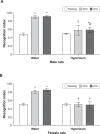Hypericum perforatum chronic treatment affects cognitive parameters and brain neurotrophic factor levels
- PMID: 30110089
- PMCID: PMC6899380
- DOI: 10.1590/1516-4446-2017-2271
Hypericum perforatum chronic treatment affects cognitive parameters and brain neurotrophic factor levels
Abstract
Objective: To evaluate the effects of Hypericum perforatum (hypericum) on cognitive behavior and neurotrophic factor levels in the brain of male and female rats.
Methods: Male and female Wistar rats were treated with hypericum or water during 28 days by gavage. The animals were then subjected to the open-field test, novel object recognition and step-down inhibitory avoidance test. Nerve growth factor (NGF), brain-derived neurotrophic factor (BDNF), and glial cell-line derived neurotrophic factor (GDNF) levels were evaluated in the hippocampus and frontal cortex.
Results: Hypericum impaired the acquisition of short- and long-term aversive memory in male rats, evaluated in the inhibitory avoidance test. Female rats had no immediate memory acquisition and decreased short-term memory acquisition in the inhibitory avoidance test. Hypericum also decreased the recognition index of male rats in the object recognition test. Female rats did not recognize the new object in either the short-term or the long-term memory tasks. Hypericum decreased BDNF in the hippocampus of male and female rats. Hypericum also decreased NGF in the hippocampus of female rats.
Conclusions: The long-term administration of hypericum appears to cause significant cognitive impairment in rats, possibly through a reduction in the levels of neurotrophic factors. This effect was more expressive in females than in males.
Conflict of interest statement
The authors report no conflicts of interest.
Figures





Similar articles
-
Evaluation of the Effect of Hypericum triquetrifolium Turra on Memory Impairment Induced by Chronic Psychosocial Stress in Rats: Role of BDNF.Drug Des Devel Ther. 2020 Dec 1;14:5299-5314. doi: 10.2147/DDDT.S278153. eCollection 2020. Drug Des Devel Ther. 2020. PMID: 33299301 Free PMC article.
-
The different effects of lithium and tamoxifen on memory formation and the levels of neurotrophic factors in the brain of male and female rats.Brain Res Bull. 2017 Sep;134:228-235. doi: 10.1016/j.brainresbull.2017.08.006. Epub 2017 Aug 9. Brain Res Bull. 2017. PMID: 28802897
-
The role of neurotrophic factors in manic-, anxious- and depressive-like behaviors induced by amphetamine sensitization: Implications to the animal model of bipolar disorder.J Affect Disord. 2019 Feb 15;245:1106-1113. doi: 10.1016/j.jad.2018.10.370. Epub 2018 Nov 29. J Affect Disord. 2019. PMID: 30699853
-
Antidepressant-like effects and cognitive enhancement of the total phenols extract of Hemerocallis citrina Baroni in chronic unpredictable mild stress rats and its related mechanism.J Ethnopharmacol. 2016 Dec 24;194:819-826. doi: 10.1016/j.jep.2016.09.023. Epub 2016 Sep 10. J Ethnopharmacol. 2016. PMID: 27623554
-
Sodium butyrate and mood stabilizers block ouabain-induced hyperlocomotion and increase BDNF, NGF and GDNF levels in brain of Wistar rats.J Psychiatr Res. 2015 Feb;61:114-21. doi: 10.1016/j.jpsychires.2014.11.003. Epub 2014 Nov 21. J Psychiatr Res. 2015. PMID: 25467060
Cited by
-
Clinical relevance of St. John's wort drug interactions revisited.Br J Pharmacol. 2020 Mar;177(6):1212-1226. doi: 10.1111/bph.14936. Epub 2020 Jan 17. Br J Pharmacol. 2020. PMID: 31742659 Free PMC article. Review.
-
The effects of Tendoflex® (polytendon complex) and Hypericum perforatum (St. John's wort oil) on repaired Achilles tendon healing in rats.Jt Dis Relat Surg. 2021;32(3):676-687. doi: 10.52312/jdrs.2021.10. Epub 2021 Nov 19. Jt Dis Relat Surg. 2021. PMID: 34842100 Free PMC article.
-
Folecitin Isolated from Hypericum oblongifolium Exerts Neuroprotection against Lipopolysaccharide-Induced Neuronal Synapse and Memory Dysfunction via p-AKT/Nrf-2/HO-1 Signalling Pathway.Evid Based Complement Alternat Med. 2022 Mar 28;2022:9419918. doi: 10.1155/2022/9419918. eCollection 2022. Evid Based Complement Alternat Med. 2022. PMID: 35388307 Free PMC article.
-
Evaluation of the Effect of Hypericum triquetrifolium Turra on Memory Impairment Induced by Chronic Psychosocial Stress in Rats: Role of BDNF.Drug Des Devel Ther. 2020 Dec 1;14:5299-5314. doi: 10.2147/DDDT.S278153. eCollection 2020. Drug Des Devel Ther. 2020. PMID: 33299301 Free PMC article.
-
Memory-Enhancing and Anxiolytic Effects of the Rose of Jericho on Sleep Deprivation-Related Cognitive and Behavioral Changes.Cureus. 2025 Feb 1;17(2):e78327. doi: 10.7759/cureus.78327. eCollection 2025 Feb. Cureus. 2025. PMID: 39896833 Free PMC article.
References
-
- Marrelli M, Statti G, Conforti F, Menichini F. New potential pharmaceutical applications of hypericum species. Mini Rev Med Chem. 2016;16:710–20. - PubMed
-
- Bano S, Ara I, Saboohi K, Moattar T, Chaoudhry B. St. John's Wort increases brain serotonin synthesis by inhibiting hepatic tryptophan 2, 3 dioxygenase activity and its gene expression in stressed rats. Pak J Pharm Sci. 2014;27:1427–35. - PubMed
MeSH terms
Substances
LinkOut - more resources
Full Text Sources
Other Literature Sources
